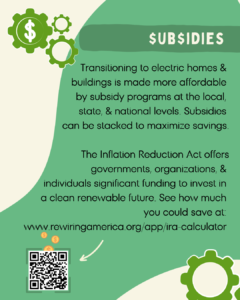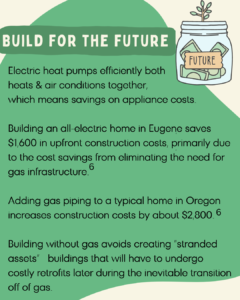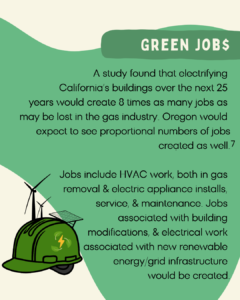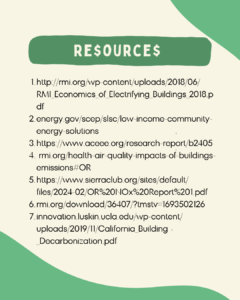Transitioning to high-efficiency appliances that run on clean, renewable energy is good for your health and good for the planet, but what about your wallet? Check out the many ways a transition to clean energy can pay off below.
Efficiency
All electric, high-efficiency appliances save money by reducing energy use and therefore utility bills. For example, electric heat pumps typically operate at 250-400% efficiency (COP of 2.5-4) – several times higher than even the highest-efficiency gas furnaces (90-98.5%) efficiency (AFUE) or electric resistance heaters (source). Heat pumps also have the added benefits of providing heating and cooling, reducing humidity, and more. This trend in efficiency can be seen across many household appliances like water heating (see graph) and induction stoves.
A typical all-electric, single-family home constructed in Eugene, Oregon will save $390 per year on utility bills compared to a new home with gas. That’s a savings of 20%. (source). The increased savings is primarily due to decreased utility bills from high-efficiency appliances.
Gas prices fluctuate and are expected to increase over time as demand declines, so these savings too will increase. Gas customers pay the price for this volatility. In comparison, the cost of renewable power has been steadily decreasing (source).
Justice & Equity
BIPOC, low-income, and other historically marginalized communities are disproportionately burdened by the health impacts of gas and by the cost of energy. American Council for an Energy-Efficient Economy’s (ACEEE’s) 2020 research revealed that low-income, Black, Hispanic, and Native American households experience significantly higher energy burdens, spending a larger share of their income on energy bills compared to the average household. These high energy burdens are associated with an increased risk of respiratory diseases, heightened stress, economic hardship, and challenges in escaping poverty.
Energy burden is the percentage of income spent on powering one’s home. The average burden for low-income households is 8.6% – about three times higher than non-low-income households. Energy burden can reach 30% or more (source). In Oregon, assistance programs only cover about 20% of the need, leaving many families in a difficult financial position. High energy burdens are linked to poor housing conditions and have been shown to impact physical and mental health, nutrition, and local economic development (source).

Graph from aceee.org/energy-burden
Renters make up about 50% of Eugene’s population and this group often has little to no control over the fuel source of their appliances or efficiency of their homes in general. Since many tenants pay their own utilities, landlords are often not effected by the energy burden of their rentals. According to a national assessment, the median renter energy burden is 13% higher than that of the median home owner (source).
A May 2024 ACEEE study, ‘The Value of Prioritizing Equitable, Efficient Building Electrification,’ found that electrifying U.S. homes could save billions in energy costs so long as it was done equitably. Some of the key findings taken from their website are below:
- Prioritizing equitable building electrification—where low- and moderate-income (LMI) households have the support they need to replace fossil fuel and electric resistance equipment when higher-income homes are electrifying—ensures that historically disinvested communities will not be left behind in the energy transition.
- 75% residential electrification produces $96 billion in net cost savings (including both retrofit costs and energy cost savings compared to the status quo) over the 2024–2050 analysis period if LMI households are included but a net cost increase of $88 billion without equitable electrification.
- The societal benefits of electrification dwarf the costs in either scenario, but prioritizing equitable electrification maximizes societal benefits: $2 trillion over the analysis period compared to $1.8 trillion without equitable electrification.
- Prioritizing equitable electrification reduces LMI household energy burden—the percentage of income spent on energy: At a 50% electrification rate overall, the average energy burden for very low-income households drops from 9% to just over 6% but increases to 10.5% when these homes are excluded.
- At 75% residential electrification, LMI household utility bill savings total $120 billion if equitable electrification is prioritized. If not, LMI household energy costs could increase $64 billion
Download the full report from ACEEE here.
Health
In Oregon, air pollution from burning fuels in buildings were attributed to an estimated 365 early deaths in 2017 (source).
In a 2024 report, outdoor fossil fuel pollution from Oregon’s homes and businesses was shown to drive health impacts estimated at almost $88 million annually.
Learn more about the health effects of burning methane in the home on our Harms of Gas Stoves page.

Graph from RMI’s Health Impacts by State
Subsidies
Transitioning to electric homes and buildings is made more affordable by subsidy programs at the local, state, and national levels. Subsidies can be stacked to maximize savings.
The Inflation Reduction Act offers governments, organizations, and individuals significant funding to invest in a clean renewable future. See how much you could save by using Rewiring America’s calculator tool or check out local subsidies at the City of Eugene website or Eugene Water and Electric Board website.
Stay tuned for more information about the Oregon rollout of the federal Inflation Reduction Act’s HOMES and HEAR programs.
Build for the Future
Electric heat pumps efficiently provide both heating and cooling in the home, which can mean savings by avoiding having to purchase a separate air conditioner.
Building an all-electric home in Eugene saves $1,600 in upfront construction costs, primarily due to the cost savings from eliminating the need for gas infrastructure. Adding gas piping to a typical home in Oregon increases construction costs by about $2,800 (source).
Building without gas avoids creating “stranded assets;” that is, buildings that will have to undergo costly retrofits later during the inevitable transition off of gas.
Green Jobs
A study by UCLA found that electrifying California’s buildings over the next 25 years would create 8 times as many jobs as may be lost in the gas industry, supporting an additional 100,000 full-time jobs in construction, manufacturing and the energy sector each year. Oregon would expect to see jobs numbers for our state proportional to our population and housing stock.
Jobs include HVAC work, both in gas removal and electric appliance installs, service, and maintenance. Jobs associated with building modifications, and electrical work associated with new renewable energy/grid infrastructure would be created.
Going fossil free is an investment in the future but it also has notable cost savings from construction, to utilities bills, to decreased social costs, and more.










